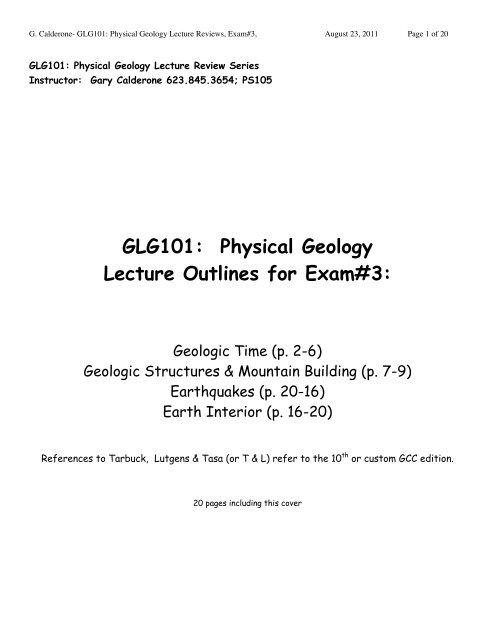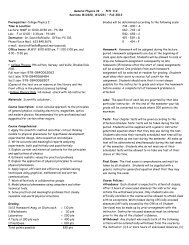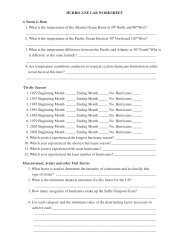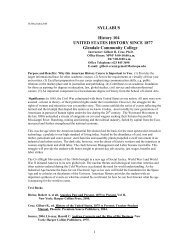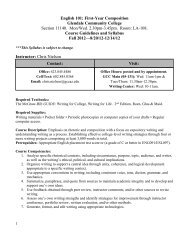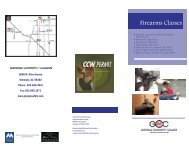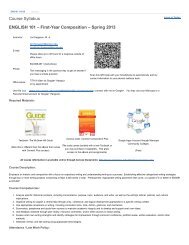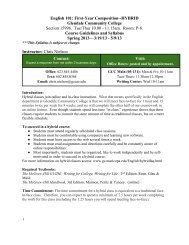GLG101: Physical Geology Lecture Outlines for Exam#3:
GLG101: Physical Geology Lecture Outlines for Exam#3:
GLG101: Physical Geology Lecture Outlines for Exam#3:
You also want an ePaper? Increase the reach of your titles
YUMPU automatically turns print PDFs into web optimized ePapers that Google loves.
G. Calderone- <strong>GLG101</strong>: <strong>Physical</strong> <strong>Geology</strong> <strong>Lecture</strong> Reviews, <strong>Exam#3</strong>, August 23, 2011 Page 9 of 20Oblique-slip faultsNote that although most faults have some oblique component, they tend to be dominantlydip- or strike- slip. So we simply classify most of them as if they were completely oneway or the other.MountainsTypes of mountains•Fold and Thrust Belts- Compressional stress-•Block Faulting & Rift Valleys- Tensional stressHorsts & Grabens•Single volcanoes or volcanic chains (island or continental arcs)- found around subductionzones•Erosional remnants- present day Appalachians <strong>for</strong>med originally as a fold and thrust beltwhen Africa collided with North America at the end of the Paleozoic. Eroded to flat.Exhumed by later uplift and differential erosion of weaker rock units.Anatomy of an orogenic belt- The Plate Tectonic or Wilson CyclePassive and active continental marginsRifting and Sea-Floor spreading to produce Passive marginDeposition of sedimentsChange in tectonic environment to produce subductionBeginning of andesitic volcanismCompressional de<strong>for</strong>mationFoldingFaultingMetamorphismContinental Collision and return to passive margin tectonicsMicroplate tectonics- Suspect TerranesSupplemental Materials:Films: Earth Revealed Series- Mountain Building & Earth Structures
G. Calderone- <strong>GLG101</strong>: <strong>Physical</strong> <strong>Geology</strong> <strong>Lecture</strong> Reviews, <strong>Exam#3</strong>, August 23, 2011 Page 10 of 20<strong>GLG101</strong>: Earthquakes <strong>Lecture</strong>s- ReviewsElastic Rebound Theory: Stress can be stored as elastic strain, then suddenly released inpart as seismic waves. The waves travel some distance- vibrating the ground orquaking it as they pass. This action is what we call an earthquake.Basic definitions:Earthquake (EQ) = shaking of ground by passage of seismic waves resulting from the releaseof stress through breakage of rockFocus the point of rupture-= usually occurs below the surface of the Earth.Epicenter = the surface location directly above the point of ruptureAftershocks = smaller Earthquakes representing adjustments of remaining rock to newmotion.Causes of earthquakesFaulting = two masses of rock sliding past one another along fault plane- Elastic reboundtheory. Buildup of strain, release in an earthquake, repeatMagma motion = as magma <strong>for</strong>ces its way to surface, rocks may break causing earthquakesExplosions = Volcanic eruptions or nuclear bombsPossible mineral phase changes <strong>for</strong> really deep earthquakesSeismic Waves-Body Waves- Waves travel through the "body of rock or body of Earth"p waves- Primary Waves- compressional waves- particle motion is back and <strong>for</strong>th- veryfast waves- 4-7 km/sec can travel through almost any materials waves - Secondary or Shear waves- particle motion is up/down and sideways(perpendicular do direction of wave travel)- slower than p-waves <strong>for</strong> the samematerial- 2-5 km/sec. Because waves propagate by shearing particles, s-waves cannottravel through fluids such as gasses and liquidsSurface Waves- waves travel along Surface of the Earth- slower than body wavesLove Waves - particle motion is a horizontal shear wave- cannot travel through fluid.Rayleigh Waves - particle motion is retrograde elliptical- just like ocean waves- althoughslower, Rayleigh waves produce very large ground motion and are responsible <strong>for</strong> muchof the destructive power of EQs.
G. Calderone- <strong>GLG101</strong>: <strong>Physical</strong> <strong>Geology</strong> <strong>Lecture</strong> Reviews, <strong>Exam#3</strong>, August 23, 2011 Page 11 of 20Effects of Earthquakes (see movie "When the Bay Area Quakes")Ground motion- from the passage of seismic wavesThe Mercali Scale: a measure of Earthquake Intensity- Ground shaking “scale”Factors influencing earthquake intensity.Distance from epicenter Rock type Construction TypeLandslides- triggered by passage of seismic wavesLiquefaction- creation of "quicksand" in wet muddy sedimentsSurface rupture- actual ground breakageFires- from rupture and ignition of gas lines etc.Seismic Sea Waves (Tsunamis)- large waves (hurricane sized or larger) caused by landshifts in earthquakesSeiches (pronounced "Say-shays")- rocking motion of water in closed baysAftershocks- "smaller earthquakes" following the main shock. These may further damagestructures weakened by the main shock. Although there will be hundreds or thousands ofaftershocks after a large earthquake, there will usually be 2 or three aftershocks of onemagnitude less than the main shock. If the main shock was a magnitude 8, some of theaftershocks may be magnitude 7- very large aftershocks!Power outages/ Water shortages/ communications out etc.Coping with the Threat of Earthquakes (see attached FEMA what to do list]Earthquake prediction.Long termSeismic frequency- some areas seem to have earthquakes at "regular" intervals of time(Parkfield Experiment)Space-time patterns- patterns in where and when earthquakes occur.Seismic gaps- areas along faults that have not ruptured in a long time. Stress is building.Short term- Parkfield ExperimentForeshocks- smaller earthquakes that may signal onset of larger oneWater level changes- possible changes in groundwater well levels due to shift prior toruptureRadon emissions- possibly due to shifts in Earth prior to ruptureGeodetic changes- shifts in location of areas prior to ruptureLow Frequency Radio Waves- <strong>for</strong> whatever reason, these may indicate immanent ruptureAnimal behavior
G. Calderone- <strong>GLG101</strong>: <strong>Physical</strong> <strong>Geology</strong> <strong>Lecture</strong> Reviews, <strong>Exam#3</strong>, August 23, 2011 Page 12 of 20Measuring Seismic WavesSeismometers- device that can detect the passage of waves through the earth. Many typesof seismometers used to measure different periods of waves World-wide seismicnetwork (WWSN)- set up after W.W.II to monitor nuclear testing.Seismographs - seismometer with a recording mechanism to show passage of wavesSeismogram - graph from a seismograph- and the fundamental source of seismic data.Record of arrival of various waves and their times. Seismograms from all the stations ofthe WWSN are stored and archived by the National Earthquake In<strong>for</strong>mation Center inGolden Colorado and several other sites as well. Nowadays the seismograms are recordeddigitally <strong>for</strong> instant data dissemination all over the world.Locating Earthquakes from seismogramsDifference in p and S velocities allow construction of Travel time curves.Difference in wave type allow <strong>for</strong> easy recognition of p and S waves on seismograms. Thetwo combined allow us to Figure out from any given seismic station, how far away anEarthquake occurred. Triangulation is neeed to give real location of epicenter. Can also getdepth to focus.Shallow focus 0-70 kmIntermediate Focus 70-350 kmDeep focus 350-700 km.Can also determine type of faulting first motion studies (don't worry about how we do thisjustthat we can do it.)Distribution of aftershocks indicate fault plane.Distribution of EarthquakesPlate boundary quakes- most earthquakes occur on and help define plate boundariesShallow focusDivergent boundaryConvergent boundaryTrans<strong>for</strong>m boundaryDeep focus- Convergent boundary onlyBenioff zones- can determine which plate is subducting—know this.Subduction angles
G. Calderone- <strong>GLG101</strong>: <strong>Physical</strong> <strong>Geology</strong> <strong>Lecture</strong> Reviews, <strong>Exam#3</strong>, August 23, 2011 Page 13 of 20Earthquake MagnitudeEarthquake magnitude- relative amplitudes of waves and energy releasedThe Richter Scale- logarithmic scale based on amplitudes of waves. An increase of oneon the scale corresponds to a factor of 10 increase in wave amplitude. Consequently,the waves produced by a Richter Magnitude 5 earthquake are 10 times greater thanthose produced in a Richter magnitude 4 earthquake; and 100 times greater than in amagnitude 3 earthquake.However, it takes about 30 times the stored strain energy to create a tenfold increase inwave amplitude. Thus, a magnitude 7 earthquake releases 30 times the strain energyof a magnitude 6 earthquake and roughly 900 times the energy of a magnitude 5earthquake. In short, it would take 900 magnitude 5 earthquakes to release the sameamount of energy as one magnitude 7 earthquake.Other magnitude scales- such as total moment magnitude and surface wave magnitudeare actually used more often by geologists. These are converted to hypotheticalRichter magnitudes <strong>for</strong> Dan Rather (the press).•Summary diagrams- attached FEMA what-to-do list•Summary films - When the Bay Area quakes; available in media center library;•Supplemental film- Earthquakes (Earth Revealed); Nova- Earthquake; The San Andreas Fault
G. Calderone- <strong>GLG101</strong>: <strong>Physical</strong> <strong>Geology</strong> <strong>Lecture</strong> Reviews, <strong>Exam#3</strong>, August 23, 2011 Page 14 of 20What to do Be<strong>for</strong>e, During, and After an EarthquakeSource: FEMA (http://www.fema.gov/library/quakef.htm). Earthquakes strike suddenly,violently and without warning. Identifying potential hazard ahead of time and advance planningcan reduce the dangers of serious injury or loss of life from an earthquake.BEFORE Check <strong>for</strong> hazards in the home.Fasten shelves securely to walls.Place large or heavy objects on lower shelves.Store breakable items such as bottled foods, glass, and china in low, closed cabinets withlatches.Hang heavy items such as pictures and mirrors away from beds, couches, and anywherepeople sit.Brace overhead light fixtures.Repair defective electrical wiring and leaky gas connections. These are potential fire risks.Secure a water heater by strapping it to the wall studs and bolting it to the floor.Repair any deep cracks in ceilings or foundations. Get expert advice if there are signs ofstructural defects.Store weed killers, pesticides, and flammable products securely in closed cabinets withlatches and on bottom shelves.Identify safe places in each room.Under sturdy furniture such as a heavy desk or table.Against an inside wall.Away from where glass could shatter around windows, mirrors, pictures, or where heavybookcases or other heavy furniture could fall over.Locate safe places outdoors.In the open, away from buildings, trees, telephone and electrical lines, overpasses, orelevated expressways.Make sure all family members know how to respond after an earthquake.Teach all family members how and when to turn off gas, electricity, and water.Teach children how and when to call 9-1-1, police, or fire department and which radio stationto tune to <strong>for</strong> emergency in<strong>for</strong>mation.Contact your local emergency management office or American Red Cross chapter <strong>for</strong> morein<strong>for</strong>mation on earthquakes.Have disaster supplies on hand.
G. Calderone- <strong>GLG101</strong>: <strong>Physical</strong> <strong>Geology</strong> <strong>Lecture</strong> Reviews, <strong>Exam#3</strong>, August 23, 2011 Page 15 of 20Flashlight and extra batteriesNonelectric can openerPortable battery-operated radio andEssential medicinesextra batteriesFirst aid kit and manualCash and credit cardsEmergency food and waterSturdy shoesDevelop an emergency communication plan.In case family members are separated from one another during an earthquake (a realpossibility during the day when adults are at work and children are at school), developa plan <strong>for</strong> reuniting after the disaster.Ask an out-of-state relative or friend to serve as the "family contact." After a disaster,it's often easier to call long distance. Make sure everyone in the family knows thename, address, and phone number of the contact person.DURING If indoors:Take cover under a piece of heavy furniture or against an inside wall and hold on.Stay inside. The most dangerous thing to do during the shaking of an earthquake is to try toleave the building because objects can fall on you.If outdoors:Move into the open, away from buildings, street lights, and utility wires.Once in the open, stay there until the shaking stops.If in a moving vehicle:Stop quickly and stay in the vehicle.Move to a clear area away from buildings, trees, overpasses, or utility wires.Once the shaking has stopped, proceed with caution. Avoid bridges or ramps that mighthave been damaged by the quake.AFTER Be prepared <strong>for</strong> aftershocks.Although smaller than the main shock, aftershocks cause additional damage and may bringweakened structures down. Aftershocks can occur in the first hours, days, weeks, or evenmonths after the quake.Help injured or trapped persons. Give first aid where appropriate. Do not move seriouslyinjured persons unless they are in immediate danger of further injury. Call <strong>for</strong> help.Listen to a battery-operated radio or television <strong>for</strong> the latest emergency in<strong>for</strong>mation.Remember to help your neighbors who may require special assistance--infants, theelderly, and people with disabilities.
G. Calderone- <strong>GLG101</strong>: <strong>Physical</strong> <strong>Geology</strong> <strong>Lecture</strong> Reviews, <strong>Exam#3</strong>, August 23, 2011 Page 18 of 20•Seismic velocity versus depth curves- Upper EarthSeismic refraction and reflection of the various waves allow us to construct a picture ofthe velocities versus depth within the Earth Basically, velocities increase with depthwith a few exceptions and jumps called discontinuities-Moho Discontinuity- crust-mantle boundary. Jump is consistent with change of rocktype from felsic/intermediate/mafic in crusts to ultramafic in mantle. confirmationfrom mantle xenoliths of peridotite-LVZ (Low Velocity Zone) = Asthenosphere- both S and P waves transmitted so materialmust behave like solid in short time frames. Large drop in wave velocities, however,suggests that material is not all that rigid.-400km Discontinuity- sharp velocity increase. Possibly due to mineral phase change orchemical change at this level. Not well known- either would work.-670km Discontinuity-sharp velocity increase. Possibly due to mineral phase change orchemical change at this level. Not well known- either would work.•Seismic velocity versus depth curves- Whole EarthShadow zones and velocities of the various waves allow us to construct a picture of thevelocities versus depth within the whole Earth•S-Wave shadow zone- Since S-Waves cannot transmit through liquids and no S-Wavesare observed to arrive beyond 103° from epicenter, then there must be a liquid layerof the Earth. Depth can be calculated by geometry. Evidence <strong>for</strong> existence of liquidcore.•P-Wave Shadow zone- No P-wave arrivals are know between 103 and 143° fromepicenter. P-Waves can transmit through liquids although their velocities will beslowed down. There<strong>for</strong>e, refraction will make them enter core more steeply. This willcreate a shadow zone in the way portrayed by the illustration in book. Depth can becalculated by geometry. Consistent with S-Wave Shadow zone <strong>for</strong> existence of liquidcore.-Gutenberg discontinuity - major drop in P-wave velocity. S waves not transmitted.There<strong>for</strong>e, material is most likely fluid. Core/mantle boundary-Slight discontinuity in p-wave arrivals traveling through inner most part of core -Chemical considerations dictate that extra pressure may allow liquid core to go to asolid at depth. Appears that there may be a solid inner core. Other evidence fromfree oscillations suggests solid inner core.
G. Calderone- <strong>GLG101</strong>: <strong>Physical</strong> <strong>Geology</strong> <strong>Lecture</strong> Reviews, <strong>Exam#3</strong>, August 23, 2011 Page 20 of 20•The Earth's magnetic field occasionally reverses (NOT every 500,000 years though, I don'tcare what your text says) irregular through time. Cause: unknown.•Magnetic field anomaliesBodies of magnetic rock perturb the usual value of the Earth's magnetic field.More magnetic rock beneath the surface magnetized in the direction of the Earth'spresent magnetic field produces positive magnetic anomalies (field strength is higherthan normal)Less magnetic rock beneath the surface OR rock magnetized opposite of the direction ofthe Earth's present magnetic field produces negative gravity anomalies (fieldstrength is less than normal)Magnetic anomalies can be used to locate metal ore bodies or depth to crystalline rock indeep sedimentary basins AND play an important role in the determinations of platemotionsEvidence from meteorites•Origin of meteorites- trajectories place most of them in asteroid belt between Jupiter &Mars. They are thought to represent either a broken up planet or original material of thesolar system that never coalesced into a planet because of Jupiter's enormous gravityfield.•Composition of meteorites- Nickel-iron. Stony- much like Peridotite in compositionPoint: Earth interior is probably made up of similar stuff•Age of meteorites- gives ultimate age of Earth at 4.6 billion years (supported by moonrocks)Summary of Earth's interior•Seismology gives layers of EarthCrust-mantle-outer core-inner coreLithosphere-asthenosphere-lower mantle (= mesosphere)-outer core-inner core•Xenoliths (inclusions), seismology, constrain properties of mantle, meteorites constraincomposition. Mantle is most probably solid (more-or-less) peridotite. Seismology,however, suggests that some composition changes may occur below asthenosphere (400 &670 km discontinuities.•Gravity, seismology, and magnetism constrain properties of core, meteorites constraincomposition. Outer core is most probably liquid iron-nickel. Seismology, however,suggests that innermost core is solid.•Age of meteorites- gives ultimate age of Earth at 4.6 billion years•Summary films: Earth Interior (Earth Revealed)


